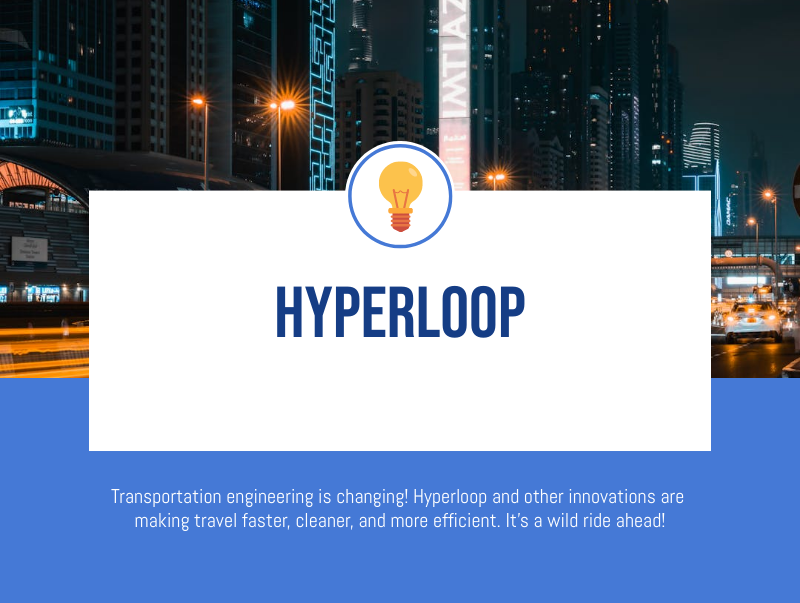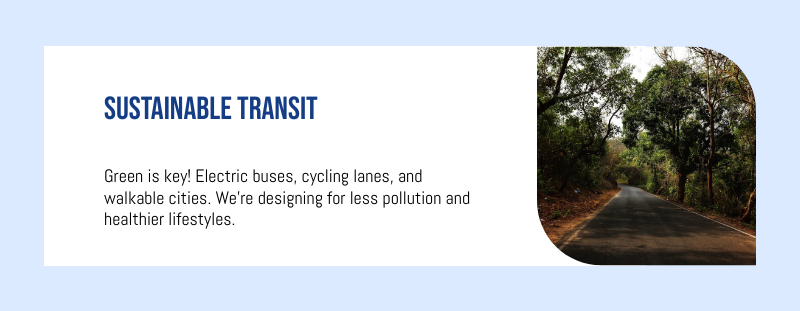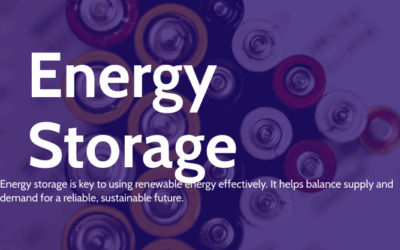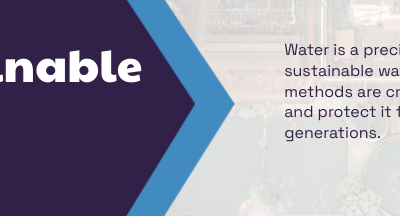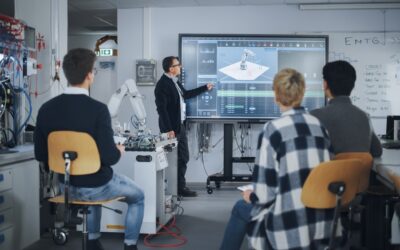Transportation engineering is entering a new era—one defined not just by efficiency and infrastructure, but by innovation, sustainability, and the reimagining of how people and goods move across vast distances. As global cities swell in population and environmental concerns become more pressing, transportation engineers are being challenged to develop faster, cleaner, and more resilient systems. At the center of this transformation lies the Hyperloop—a high-speed ground transportation system proposed to drastically cut travel time between major cities. But the Hyperloop is only one of several technologies reshaping the future of mobility.
The Current State of Transportation Engineering
Transportation engineering has traditionally focused on optimizing roads, bridges, tunnels, and public transit systems. Success has largely been measured in terms of traffic flow, safety, accessibility, and cost-efficiency. Yet the 21st century is imposing new criteria: environmental sustainability, energy consumption, and the integration of smart technologies.
Cities and regions around the world are contending with aging infrastructure, mounting congestion, and rising emissions. These problems require not just incremental improvements, but transformational ideas—radical reinventions of existing systems and bold new modes of travel.
Hyperloop: A Game-Changer in Transit
Among the most anticipated advancements is the Hyperloop. Originally conceptualized as a vacuum-sealed pod system propelled at speeds over 700 miles per hour, the Hyperloop aims to marry the speed of air travel with the convenience and energy-efficiency of rail.
Hyperloop systems utilize low-pressure tubes to reduce air resistance and magnetic levitation or linear electric motors to propel passenger pods. The goal is ultra-fast, low-friction transport that operates autonomously and is powered by renewable energy.
Engineering Challenges of Hyperloop Systems
To realize the Hyperloop’s promise, engineers must overcome several technical and logistical hurdles:
- Tube Infrastructure: Building low-pressure tubes that can extend hundreds of miles across diverse terrains and withstand environmental pressures requires advanced materials and meticulous design.
- Propulsion and Levitation: Engineers must refine linear induction motors and magnetic levitation systems to ensure smooth, energy-efficient acceleration and deceleration.
- Safety and Emergency Protocols: Maintaining vacuum conditions while providing fail-safes for emergencies is a complex safety engineering challenge.
- Regulatory Approval: Transportation engineering is not just about physical systems—it also involves navigating regulatory frameworks, land rights, and public trust.
Despite these challenges, test facilities have shown early promise, and multiple companies are investing in prototype development. Transportation engineers working on Hyperloop initiatives are contributing to breakthroughs in material science, pressure regulation, AI-based control systems, and more.
Urban Air Mobility and Flying Vehicles
While Hyperloop systems address intercity travel, the question of intra-city congestion remains critical. Urban air mobility (UAM) offers another futuristic solution, bringing vertical takeoff and landing (VTOL) vehicles into city airspace. These flying taxis could revolutionize last-mile delivery and short-range commuting.
For transportation engineers, UAM presents challenges such as:
- Designing air corridors and vertiports integrated with urban infrastructure.
- Ensuring robust safety systems in densely populated environments.
- Developing noise-reduction technologies and efficient battery systems.
Moreover, engineers must collaborate with aerospace professionals to design hybrid infrastructure that accommodates both terrestrial and aerial mobility.
Smart Roads and Connected Infrastructure
The future of transportation engineering is not only about new vehicles, but also about smarter infrastructure. Sensor-laden highways, vehicle-to-infrastructure (V2I) communication systems, and AI-powered traffic management are already in development.
Key innovations include:
- Self-Healing Materials: Roads made with self-healing asphalt or concrete can detect and repair cracks autonomously, extending lifespan and reducing maintenance costs.
- Dynamic Traffic Systems: AI and machine learning algorithms enable real-time traffic rerouting, helping reduce congestion and emissions.
- Wireless Charging Lanes: Engineers are testing road surfaces embedded with induction coils that can charge electric vehicles as they drive.
These technologies reflect a shift in transportation engineering from static to dynamic systems—ones that respond to real-time data and adapt to changing conditions.
Sustainable Design and Green Transit Solutions
Sustainability is no longer optional in transportation engineering—it is a core design principle. With transportation being a major contributor to greenhouse gas emissions, engineers are prioritizing sustainable materials, energy efficiency, and modal shifts.
Trends shaping sustainable transport include:
- Transit-Oriented Development (TOD): Designing cities around public transit hubs encourages lower car usage and denser, more walkable neighborhoods.
- Electrification of Public Transit: Buses, trams, and rail systems are transitioning to electric power, reducing urban air pollution and reliance on fossil fuels.
- Active Transport Infrastructure: Engineers are incorporating more pedestrian paths, cycling lanes, and micro-mobility infrastructure to support healthier, low-emission travel.
Hyperloop systems also contribute to sustainability goals by offering electric-powered, high-efficiency alternatives to short-haul flights.
Automation and Autonomous Vehicles
Autonomous vehicles (AVs) are another major frontier in transportation engineering. While much attention is given to self-driving cars, transportation engineers are exploring broader systems that integrate AVs into cities and highways.
Design considerations include:
- Dedicated AV lanes and intersections.
- AV-compatible signage and road markings.
- New urban layouts that deprioritize traditional parking and driving lanes.
The introduction of AVs also changes how engineers think about safety margins, congestion patterns, and human-machine interaction. The eventual mass adoption of AVs could drastically alter how roads are designed and maintained.
Tunneling, Subterranean Transit, and Multilayered Cities
A growing number of transportation engineers are exploring underground networks as a means of avoiding surface-level congestion. Companies are developing tunnel-boring technology to create multi-tiered city transit systems beneath urban areas.
These tunnels can be used for:
- High-speed freight delivery systems.
- Underground express routes for emergency and government vehicles.
- Subterranean Hyperloop or pod-based transit.
Efficient tunneling and subterranean design require not only precision engineering but also innovative geotechnical analysis, ventilation solutions, and seismic safety planning.
Global Implications and Equity in Future Transit Systems
As new transportation systems are developed, equitable access remains a critical issue. Hyperloop lines between major urban centers may drive economic growth, but engineers must also consider:
- Rural access and integration.
- Pricing models that support accessibility.
- Infrastructure investments in underserved areas.
Transportation equity is no longer just a policy issue—it’s a core consideration in system design. Engineers are increasingly involved in modeling the social impact of new systems to ensure benefits are broadly distributed.
The Role of Data in Future Transportation Engineering
Data is the foundation of next-generation transportation engineering. Engineers use simulations, predictive modeling, and digital twins to design, test, and refine infrastructure systems before a single component is built.
With the advent of 5G and real-time IoT sensors, transportation networks will be able to:
- Anticipate maintenance needs.
- Adjust traffic lights dynamically.
- Coordinate multi-modal transport systems.
- Monitor structural health in bridges and tunnels.
The shift toward data-centric transportation engineering requires new skills, including software engineering, systems integration, and AI model training.
A New Era of Possibility
The transportation engineering field is on the cusp of a renaissance. The Hyperloop promises to revolutionize long-distance travel, urban air mobility is poised to take flight, and AI-integrated smart infrastructure is transforming how cities function. What was once science fiction is now becoming an engineering reality.
For the modern transportation engineer, the future demands more than technical proficiency—it requires vision, adaptability, and cross-disciplinary collaboration. Success will depend on building systems that are not only faster and more efficient but also more sustainable, inclusive, and intelligent.
As new materials, smarter software, and unprecedented mobility concepts continue to emerge, one thing is clear: the future of transportation engineering has already begun. Hyperloop is just the beginning.

